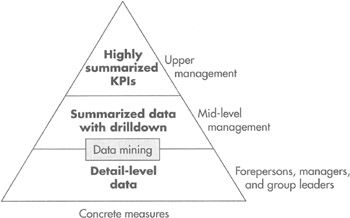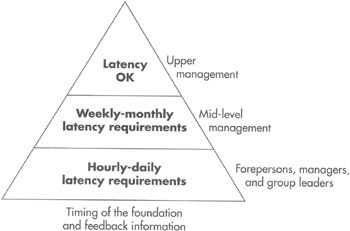Business Intelligence at Many Levels
In Chapter 1, we discussed the fact that business intelligence should be utilized at all levels of an organization to promote effective decision making. While it is true that business intelligence is useful throughout the organization, the same type of information is not needed at each level. Different levels within the organization require different types of business intelligence for effective decision making.
As we look at what is required at each level, keep in mind the Effective Decisions Triangle from Figure 1-1 We will transform that triangle into a pyramid as we examine the specific goals, concrete measures, and the timing of the foundation and feedback information required at each level. (See Figure 2-1, Figure 2-2, and Figure 2-3.)

Figure 2-1: Specific goals at each level of the organization

Figure 2-2: Concrete measures at each level of the organization

Figure 2-3: Timing of the foundation and feedback information at each level of the organization
The Top of the Pyramid
Decision makers at the upper levels of our organizations are charged with looking at the big picture. They are charged with setting long-term goals for the organization. Decision makers need to have a broad overview of their area of responsibility and not get caught up in the minutiae.
Highly Summarized Measures
The business intelligence utilized at this level needs to match these characteristics. The measures delivered to these decision makers must be highly summarized. In many cases, each measure is represented, not by a number, but by a status indicator showing whether the measure is in an acceptable range, is starting to lag, or is in an unacceptable range. These highly summarized measures are known as Key Performance Indicators.
| Definition | Key Performance Indicators (KPIs) are highly summarized measures designed to quickly relay the status of that measure. They usually reflect the most vital aspects of the organization. |
KPIs are used to provide these high-level decision makers with a quick way to determine the health of the essential aspects of the organization. KPIs are often presented as a graphical icon, such as a traffic light or a gauge, designed to convey the indicator's status at a glance. We discuss KPIs in greater detail in Chapter 9 of this book.
Higher Latency
Because these upper-level decision makers are dealing in long-term policies and direction, they do not need up-to-the-minute business intelligence. Another way to state this is to say they can have more latency in their business intelligence. These decision makers need to see downward trends in time to make corrections. They do not need to see the daily blips in the organization's operation.
| Definition | The latency of business intelligence is the amount of time between the occurrence of a transaction and the loading of that transaction's information into the business intelligence system. |
Mid-Level
Mid-level decision makers are managing the operation of departments and other working units within the organization. They are setting short-term goals and doing the planning for the functioning of these areas. Mid-level decision makers are still at a level where they should not be in the details of day-to-day processes.
Summarized Measures with Drilldown
These mid-level decision makers need business intelligence that is still summarized, but they often need to drill down into this information to get at more detail. Therefore, these decision makers can make use of printed reports along with interactive systems allowing data-led discovery. These decision makers can also make use of information from data mining.
Some Latency Acceptable
Because these decision makers are closer to the everyday functions, they may require business intelligence with less latency. In some cases, they may need to see measures that are updated daily. In other cases, these decision makers are looking for trends discernable from weekly or monthly loads.
The Broad Base
At the broad base of our business intelligence pyramid are the forepersons, managers, and group leaders taking care of daily operations. These people are setting daily operational goals and making decisions on resource allocation for the next week, the next day, or perhaps the next shift. They are planning the next sales campaign or maybe just the next sales call. These decision makers usually need business intelligence systems with high availability and high responsiveness.
Measures at the Detail Level
These decision makers are dealing with the details of the organization's operations. They need to be able to access information at the detail level. In some cases, the work groups these decision makers are responsible for are small enough that they can see the detail for the work group directly without being overwhelmed. In other cases, measures need to be summarized, but drilldown to the detail level will probably be required. These decision makers may utilize some forms of data mining to help discern trends and correlations in daily information.
Low Latency
Because these low-level decision makers are managing day-to-day operations, they need to react to changes in feedback information quickly. For this reason, they can tolerate little latency. In some cases, these decision makers require data that is no more than one day old, one hour old, or even less.
EAN: 2147483647
Pages: 112
- ERP System Acquisition: A Process Model and Results From an Austrian Survey
- Enterprise Application Integration: New Solutions for a Solved Problem or a Challenging Research Field?
- The Effects of an Enterprise Resource Planning System (ERP) Implementation on Job Characteristics – A Study using the Hackman and Oldham Job Characteristics Model
- Distributed Data Warehouse for Geo-spatial Services
- A Hybrid Clustering Technique to Improve Patient Data Quality